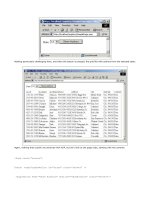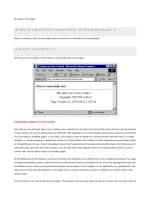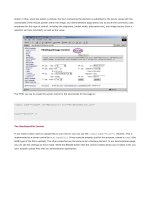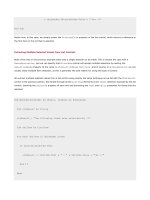Professional ASP.NET 1.0 Special Edition- P5 ppsx
Bạn đang xem bản rút gọn của tài liệu. Xem và tải ngay bản đầy đủ của tài liệu tại đây (342.91 KB, 40 trang )
Let's have a look at the practicalities of the CLR and CLS.
Common API
In the previous version of Visual Studio, common functionality was always far harder to implement than it should have
been. For C++ programmers, the Windows API is a natural home, but Visual Basic programmers had to use custom
controls and libraries, or delve into the API itself. This isn't complex, and can yield great benefits, but there is no
consistency.
With .NET we now have a common API and a great set of class libraries. For example, consider the case of TCP/IP network
applications. C++ programmers generally write directly to Winsock, whereas Visual Basic programmers prefer to use
custom controls on their forms. The .NET framework provides a
System.Net.Sockets namespace encompassing all of
the networking functionality, and its usage is the same for each language.
For example, consider the case of writing to a UDP port - you can see the only differences in the code are the syntax of
the language:
Visual Basic .NET
Dim Client As UdpClient
Dim HostName As String
Dim HostIP As IPHostEntry
Dim GroupAddress As IPAddress
Dim Remote As IPEndPoint
HostName = DNS.GetHostName()
HostIP = DNS.GetHostByName(HostName)
Client = New UdpClient(8080)
GroupAddress = IpAddress.Parse("224.0.0.1")
Client.JoinMultiCastGroup(GroupAddress, 500)
Remote = New IPEndPoint(GroupAddress, 8080)
Client.Send(".NET is great", 13, Remote)
C#
UdpClient Client;
String HostName;
IPHostEntry HostIP;
IPAddress GroupAddress;
IPEndPoint Remote;
HostName = DNS.GetHostName();
HostIP = DNS.GetHostByName(HostName);
Client = new UdpClient(8080);
GroupAddress = IpAddress.Parse("224.0.0.1");
Client.JoinMultiCastGroup(GroupAddress, 500);
Remote = new IPEndPoint(GroupAddress, 8080);
Client.Send(".NET is great", 13, Remote);
JScript .NET
var Client : UdpClient;
var HostName : String;
var HostIP : IPHostEntry;
var GroupAddress : IPAddress;
var Remote : IPEndPoint;
HostName = DNS.GetHostName();
HostIP = DNS.GetHostByName(HostName);
Client = new UdpClient(8080);
GroupAddress = IpAddress.Parse("224.0.0.1");
Client.JoinMultiCastGroup(GroupAddress, 500);
Remote = new IPEndPoint(GroupAddress, 8080);
Client.Send(".NET is great", 13, Remote);
Common Types
One of the ways in which cross language functionality is made available is by use of common types. Those Visual Basic
programmers (and I was one) who delved into the Windows API, always had the problem about converting types. Strings
were the worst, because the API is C/C++ based, which uses Null terminated strings, so you always had to do conversion
and fixed string handling stuff. It was ugly.
With the CLS there is a common set of types, so no conversion is required. The previous chapter detailed these, showing
their range and size, and explained that the various compilers will convert native types into CLS ones. The conversion
works like this:
Type
Visual
Basic .NET
C# JScript .NET
System.Boolean Boolean Bool Boolean
System.Byte Byte Byte Byte
System.Char Char Char Char
System.DateTime Date
No direct equivalent. Use the CLS
type.
No direct equivalent. JScript .NET has its own
Date type.
System.Decimal Decimal Decimal Decimal
System.Double Double Double DoubleNumber
System.Int16 Short Short Short
Type Visual Basic .NET C# JScript .NET
System.Int32 Integer Int Int
System.Int64 Long Long Long
System.UInt16 No direct equivalent. Ushort Ushort
System.UInt32 No direct equivalent. Uint Uint
System.UInt64 No direct equivalent. Ulong Ulong
System.SByte No direct equivalent. Sbyte Sbyte
System.Single Single Float Float
System.String String String String
Note that not all languages have equivalents of the CLS types. For example, JScript .NET implements dates using the
standard JScript
Date object. However, you can convert between various type formats, as well as declaring the CLS types
directly.
Cross-Language Inheritance
Another area where the CLS has helped is the area of inheritance. Assuming that you use the common types in your class
interfaces, then inheriting classes written in other languages is no different to that of inheriting from the same language.
We showed a brief example in the previous chapter, when discussing the CLR and common functionality, but a fuller
example makes this clear. For example, suppose that you had the following Visual Basic class:
Public Class Person
Private _firstName As String
Private _lastName As String
Sub New()
End Sub
Sub New(firstName As String, lastName As String)
_firstName = firstName
_lastName = lastName
End Sub
Public Property FirstName() As String
' property code here
End Property
Public Property LastName() As String
' property code here
End Property
End Class
You could write another program, perhaps in C#, that inherits from it:
public class programmer : Person
{
private int _avgHoursSleepPerNight;
public programmer(): base()
{
}
public programmer(string firstName, string lastName)
: base(firstName, lastName)
{
}
public programmer(string firstName, string lastName, int hoursSleep)
: base(firstName, lastName)
{
_avgHoursSleepPerNight = hoursSleep;
}
public int AvgHoursSleepPerNight
{
get { return _avgHoursSleepPerNight; }
set { _avgHoursSleepPerNight = value; }
}
~programmer()
{
}
}
This brings great flexibility to development, especially where team development is concerned.
Another great point about this is that many of the base classes and web controls are inheritable. Therefore, in any
language, you can extend them as you wish. A good example of this is the ASP.NET
DataGrid control. Say you didn't
want to use paging, but wanted to provide a scrollable grid, so browsers that supported inline frames would allow the
entire content of the grid to be rendered within a scrollable frame. You can create your own control (say, in Visual Basic),
inheriting everything from the base control (perhaps written in C#), and then just output the normal content within an
IFRAME. This sort of thing is extremely easy to do with the new framework.
Cross-Language Debugging and Profiling
The cross language debugging features are really cool, and provide a huge leap forward over any debugging features
we've ever had before. Both the framework and Visual Studio .NET come with visual debuggers, the only difference being
that the Visual Studio .NET debugger allows remote debugging as well as edit and continue. The debuggers work through
the CLR, and allow us to step through ASP.NET pages and into components, whatever the language. Along with debugging
comes tracing and profiling, with the ability to use common techniques to track code.
Both of these topics are covered in more detail in Chapter 22.
Performance Issues
Performance is always a question in people's minds, and often gets raised during beta testing when there's lots of
debugging code hanging around in the product. Even in the early betas it was clear that ASP.NET was faster than ASP, with
figures showing that it was 2-3 times as fast.
One of the reasons for this performance improvement is the full compilation of code. Many people confuse Intermediate
Language (IL) and the CLR with byte-code and interpreters (notably Java), and assume that performance will drop. Their
belief in this deepens when they first access an
aspx page, because that first hit can sometimes be slow. That's because
pages are compiled on their first hit, and then served from the cache thereafter (unless explicit caching has been disabled).
Appendix B has a list of tips and tricks to help with performance.
Languages
Although all languages compile to IL and then to native code, there may be some slight performance differences, due to
the nature of the compiler and the language. In some languages, the IL produced may not be as efficient as with others
(some people have said that the C# compiler is better than the Visual Basic one), but the effects should be imperceptible.
It's only under the highest possible stress situation that you may find differences, and to be honest, I wouldn't even
consider it a problem.
Late Bound Code
One of the greatest advantages of the CLR is fully typed languages. However, you can still use JScript without datatypes,
allowing legacy code to continue working. The disadvantage of this is that types then have to be inferred, and this will
have a performance impact.
In Visual Basic, if strict semantics are not being used (either by the
Option Strict Off page directive or by the
/optionstrict- compiler switch), then late-bound calls on object types are handled at run-time rather than compile
time.
Common Examples
Experienced developers probably won't have much trouble using the new features of the languages, or even converting
from one language to another. However, there are plenty of people who use ASP and VBScript daily to build great sites,
but who have little experience of advanced development features, such as the object oriented features in .NET. That's
actually a testament to how simple ASP is, but now that ASP.NET is moving up a gear, it's important that you make the
most of these features.
To that end, this section will give a few samples in Visual Basic .NET, C# and JScript .NET, covering a few common areas.
This will help should you want to convert existing code, write new code in a language that you aren't an expert in, or
perhaps just examine someone else's code. We won't cover the definition of classes and class members again in this
section, as they've had a good examination earlier in the chapter.
Variable Declaration
The first point to look at is that of variable declaration.
Visual Basic .NET
Visual Basic .NET has the same variable declaration syntax as the previous version, but now has the ability to set initial
values at variable declaration time. For example:
Dim Name As String = "Rob Smith"
Dim Age As Integer = 28
Dim coolDude As New Person("Vince", "Patel")
C#
C# follows the C/C++ style of variable declaration:
string Name = "Rob Smith";
int Age = 28;
coolDude = new Person("Vince", "Patel");
JScript .NET
JScript .NET uses the standard JScript declaration method, with the addition of optional types:
var Name : String = "Rob Smith";
var Age = 28;
var coolDude : Person = new Person("Vince", "Patel")
Functions and Procedures
Declaring procedures is similar in all languages.
Visual Basic .NET
Procedures and functions follow similar syntax to previous versions:
Private Function GetDiscounts(Company As String) As DataSet
Public Sub UpdateDiscounts(Company As String, Discount As Double)
The major difference is that by default all parameters are now passed by value, and not by reference. And remember that
Optional parameters also now require a default value:
' incorrect
Function GetDiscounts(Optional Comp As String) As DataSet
' correct
Function GetDiscounts(Optional Comp As String = "Wrox") As DataSet
Returning values from functions now uses the Return statement, rather than setting the function name to the desired
value. For example:
Function IsActive() As Boolean
' some code here
Return True
End Function
The way you call procedures has also changed. The rule is that arguments to all procedure calls must be enclosed in
parentheses. For example:
UpdateDiscounts "Wrox", 5 ' no longer works
UpdateDiscounts("Wrox", 5) ' new syntax
C#
C# doesn't have any notion of procedures - there are only functions that either return or don't return values (in which case
the type is
void). For example:
bool IsActive()
{
// some code here
return true;
}
void UpdateDiscounts(string Company, double Discount)
{
return;
}
To call procedures, C# requires that parentheses are used.
JScript .NET
For JScript .NET the declaration of functions is changed by the addition of types.
function IsActive() : Boolean
{
// some code here
return true;
}
function UpdateDiscounts(Company : String, Discount : Double) : void
{
return;
}
To call procedures, JScript .NET requires that parentheses are used.
Syntax Differences
There are a few syntactical differences that confuse many people when switching languages for the first time. The first is
that Visual Basic isn't case sensitive, but the other languages are - it still catches me out. Other things are the use of line
terminators in C# and JScript, which use a semi-colon. Many people switching to these languages complain about them,
but the reason they are so great is that it makes the language free form - the end of the line doesn't end the current
statement. This is unlike Visual Basic, where the end of the line is the end of the statement, and a line continuation
character is required for long lines.
Listed below are some of the major syntactical differences between the languages.
Loops
Visual Basic .NET
There are four loop constructs in Visual Basic, and the syntax of one has changed in Visual Basic .NET. The first is the
For…Next loop:
For counter = start To end [Step step]
Next [counter]
For example:
For count = 1 To 10
Next
The second is the While loop, for which the syntax has changed - the new syntax is:
While condition
End While
For example:
While count < 10
End While
In previous versions of Visual Basic the loop was terminated with a
Wend statement.
The third is the
Do…Loop, which has two forms:
Do [(While | Until) condition]
Loop
or:
Do
Loop [(While | Until) condition]
The difference between these two is the placement of the test condition. In the first instance the test is executed before
any loop content, and therefore the content may not get executed. In the second case the test is at the end of the loop,
so the content is always executed at least once. For example:
Do While count < 10
Loop
Do
Loop While count < 10
The For Each loop construct is for iterating through collections:
For Each element In collection
Next [element]
For example:
Dim ctl As Control
For Each ctl In Page.Controls
.
Next
C#
C# has the same number of loop constructs as Visual Basic. The first is the
for loop:
for ([initializers] ; [expression] ; [iterators])
For example:
for (count = 0 ; count < 10 ; count++)
Each of these parts is optional. For example:
for ( ; count < 10; count++)
for ( ; ; count++)
for (count = 0 ; ; count++)
for ( ; ; )
The last of these produces an infinite loop.
The second is the
while loop:
while (expression)
For example:
while (count < 10)
The third is the do…while loop:
do statement while (expression);
For example:
do
while (count < 10);
The foreach loop construct is for iterating through collections:
foreach (type identifier in expression)
For example:
foreach (Control ctl in Page.Controls)
You can also use this for looping through arrays:
String[] Authors = new String[]
{"Alex", "Brian", "Dave", "Karli", "Rich", "Rob"};
foreach (String Author in Authors)
Console.WriteLine("{0}", Author);
One point to note about loops in C# is that the loop affects the code block after the loop. This can be a single line or a
bracketed block. For example:
for (count = 0 ; count < 10 ; count++)
Console.WriteLine("{0}", count);
or, if more than one line is required as part of the loop:
for (count = 0 ; count < 10 ; count++)
{
Console.Write("The value is now: ");
Console.WriteLine("{0}", count);
}
JScript .NET
JScript .NET has the same number of loop constructs as C# and Visual Basic .NET, with the syntax being more C# like. The
first is the
for loop, where, unlike C#, all parts of the loop are required:
for (initializers ; expression ; iterators)
For example:
for (count = 0 ; count < 10 ; count++)
The second is the while loop:
while (expression)
For example:
while (count < 10)
The third is the do…while loop:
do statement while (expression);
For example:
do
while (count < 10);
The fourth loop construct is for iterating through objects and arrays:
for (identifier in [object | array])
For example:
for (ctl in Page.Controls)
or, for looping through arrays:
var Authors :String= new String[]
{"Alex", "Brian", "Dave", "Karli", "Rich", "Rob"};
foreach (String Author in Authors)
Console.WriteLine("{0}", Author);
One point to note about loops in JScript .NET is that the loop affects the code block after the loop. This can be a single line
or a bracketed block. For example:
for (count = 0 ; count < 10 ; count++)
Console.WriteLine("{0}", count);
or, if more than one line is required as part of the loop:
for (count = 0 ; count < 10 ; count++)
{
Console.Write("The value is now: ");
Console.WriteLine("{0}", count);
}
Type Conversion
Type conversion of one data type to another is an area that causes a great deal of confusion, especially for those
programmers who are used to a type-less language such as VBScript. When dealing with strongly typed languages you
either have to let the compiler, or runtime, convert between types (if it can) or explicitly perform the conversion yourself.
The method of conversion depends upon the language:
Visual Basic .NET
In Visual Basic .NET there are two ways to do this. The first uses
CType:
Dim AgeString As String
Dim Age As Integer
AgeString = "25"
Age = CType(AgeString, Integer)
The CType function takes an object and a data type, and returns the object converted to the data type.
The other way is to use the data type as a cast function:
Age = CInt(AgeString)
C#
In C# we just place the type in parentheses before the expression we wish to convert. For example:
Age = (int)AgeString;
JScript .NET
To cast in JScript .NET we use a cast function. For example:
Age = int(AgeString)
Summary
In this chapter we've examined the languages supplied with .NET, and discovered that the underlying framework provides
a rich development environment. The whole issue, and arguments that go along with it, of which language is better, or
more suitable, has simply disappeared. The language that's best is the one you are most familiar with. Apart from a few
small areas, the major difference between the .NET languages is the syntax.
We've also looked at the enhancements to the existing languages that bring them into line with the CLR and CLS, how
these features are compatible across all languages, and the benefits they bring. Features such as cross-language
development, debugging, and tracing may not seem that great if you only use one language, but the flexibility it brings
is immeasurable, especially when combined with the extensive class libraries.
Now that we've examined the languages, it's time to start to use them and look in detail at the process of writing ASP.NET
pages.
Writing ASP.NET Pages
Now it's time to get serious- we've taken a high-level look at the .NET framework, and seen a few quick examples of
ASP.NET pages, so now we're going to dive in and look at how we create ASP.NET pages in more detail. Whether we call
them ASP.NET pages or Web Forms, these files form the core of all ASP.NET applications. In this chapter, we will look at:
The old way of creating ASP pages versus the new way with ASP.NET.
The steps a page goes through as it is processed.
How to use the various features of the Page object.
Breaking up a page into reusable objects called User Controls.
Once we reach the end of this chapter, we will have learned the core essentials for the rest of the ASP.NET world.
Everything we do for the remainder of the book will draw on the page framework that we are about to discuss.
Coding Issues
In Chapter 1 we looked at some of the main disadvantages of existing ASP applications, showing why we needed a new
version, and how ASP.NET solves some of tho se problems. W e also saw that ASP.NET introduces a new way of coding, and
for those of you who have programmed in event-driven languages, such as Visual Basic, this model will seem familiar. It
might, at first, seem a little alien to programmers who have only coded in script languages such as VBScript. However, it' s
extremely simple, providing many advantages, and leads to much more structured code. The code is no longer intermixed
with the HTML, and its event-driven nature means it is more easily structured for better readability and maintainability.
We saw in the first chapter how this worked for an
OnClick event on a server control, and how the code to be run was
broken out into a separate event procedure. That example showed a list of states in a
DropDownList Server Control.
Using lists like this is extremely common, and often the list of items is generated from a data store. To understand the
difference between the existing ASP architecture, and the new event-driven ASP.NET architecture, let's take a sample
page and compare the old and the new.
Coding the Old Way
To produce a list of items from a data store in ASP, you have to loop through the list of items, manually creating the HTML.
When the item is selected, the form is then posted back to the server. It looks something like this (OldAsp.asp):
<html>
<form action="OldAsp.asp" method="post">
Please select your delivery method:
<select id="ShipMethod" Name="ShipMethod" size="1">
<%
Dim rsShip
Dim SQL
Dim ConnStr
Dim ItemField
Set rsShip = Server.CreateObject("ADODB.Recordset")
SQL = "SELECT * FROM Shippers"
ConnStr = "Driver={SQL Server}; Server=localhost; " & _
"Database=Northwind; UID=sa"
rsShip.Open SQL, ConnStr
While Not rsShip.EOF
Response.Write "<option value='" & _
rsShip("ShipperID") & "'>" & _
rsShip("CompanyName") & "</option>" & vbCrLf
rsShip.MoveNext
Wend
rsShip.Close
Set rsShip = Nothing
%>
</select>
<br>
<input type="submit" value="Place Order">
</form>
<%
If Len(Request.Form("ShipMethod")) > 0 Then
Response.write "<br>Your order will be delivered via " & _
Request.Form("ShipMethod")
End If
%>
</html>
This code is fairly simple - it loops through a recordset building a SELECT list, allows the user to select a value and submit
that back to the server. In many situations you'd probably build some sort of database query or update based upon the
selected value, but in our example we are printing out the selected value:
Notice that only the value is available in the submitted page, and not the text value selected - that's just the way SELECT
lists work. This is fine if we're going to use the value in some form of data query, but not if we need to display it again. You
can see how this happens by looking at the HTML generated:
<html>
<form action="OldAsp.asp" method="post">
Please select your delivery method:
<select id="ShipMethod" Name="ShipMethod" size="1">
<option value='1'>Speedy Express</option>
<option value='2'>United Package</option>
<option value='3'>Federal Shipping</option>
</select>
<br>
<input type="submit" value="Place Order">
</form>
<br>Your order will be delivered via 1
</html>
The option elements have their value attribute as the ID of the shipping method, and it's the value that's accessible
from server-side ASP code.
Coding in ASP.NET Pages
As ASP.NET is event based, you need to understand the order of events, so that you can see where the equivalent code
would go. Code within these events is processed sequentially, but the events are processed only when they are raised. For
example, the event order is:
These events are:









